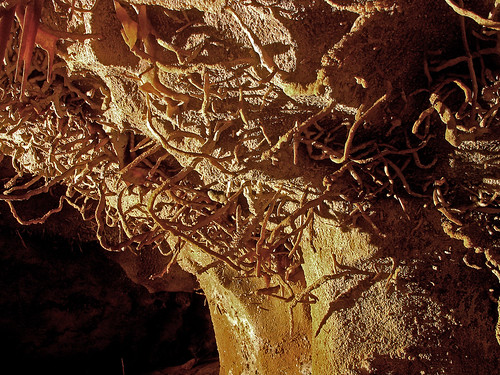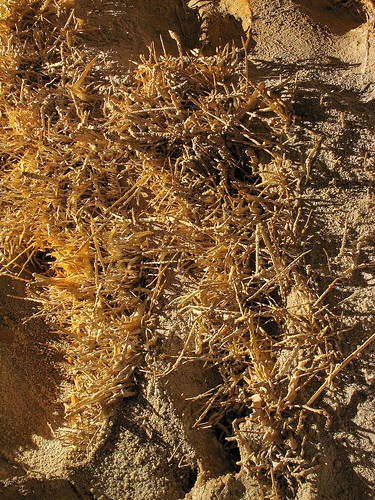You are using an out of date browser. It may not display this or other websites correctly.
You should upgrade or use an alternative browser.
You should upgrade or use an alternative browser.
Formation of Helictites?
- Thread starter alastairgott
- Start date
graham said:I would doubt it. Given that calcite growth depends on degassing of CO2 from water when it hits the cave atmosphere, it is difficult to see how saturated water droplets would be moving about in that same atmosphere, without having already reached equilibrium with the cave atmosphere.TheBitterEnd said:Very small water droplets, as in an aerosol, could respond to forces other than gravity, such as Brownian motion, convection, etc. Crystal growing at school seems to indicate that there will be preferential deposition on existing seed crystals. So I wonder if an aerosol (or vapor) of water saturated with CaCO3 could contribute to Helictitites such as the one in Fulk's picture?
There is one very important condition: equilibrium. Imagine closed high room with dropping water - there should be equilibrium among air, water wapor, water drops with soluted bedrock, CO2 and other substances (impurities), very thin layer of solution on bedrock or speleothemes. Because of equilibrium the coarse forces (gravitation, airflow, temperature or humidity gradients) have no influence. So the much more subtle forces as difference between concave or convex surface or difference of grow in direction of main crystal axe and in other directions, micro-impurities, electromagnetic forces, ... may apply. Thats all. And enough time.
I don't think anyone has come up with a definitive answer to these quirks of Nature! It seems that of the various suggestions, any could be right or somewhere near so, in one situation and not another.
For just to put the cat among the pigeons - or bats - there are some tiny helictites growing on a ball-valve on the cold mains water to an open tank where I work. It's in a large room, rather cool in Winter but sometimes hot and humid in Summer. The water is hard (South Dorset's chalk aquifer) and is creating a hard calcite crust around the tank sides an inch or so above the surface - but these helictites are delicate little whiskers perhaps 10mm long so far, growing more or less horizontally from the fitting. They might be associated with spray but seem too fine and regular, more like "proper" cave helictites, for that.
For just to put the cat among the pigeons - or bats - there are some tiny helictites growing on a ball-valve on the cold mains water to an open tank where I work. It's in a large room, rather cool in Winter but sometimes hot and humid in Summer. The water is hard (South Dorset's chalk aquifer) and is creating a hard calcite crust around the tank sides an inch or so above the surface - but these helictites are delicate little whiskers perhaps 10mm long so far, growing more or less horizontally from the fitting. They might be associated with spray but seem too fine and regular, more like "proper" cave helictites, for that.
cap n chris
Well-known member
Could it be that there are many types and hence no definitive answer since there's more than one way they can form.
graham
New member
Cap'n Chris said:Could it be that there are many types and hence no definitive answer since there's more than one way they can form.
Yes, alternately no.
There are many many types, but there are also underlying broad principles which determine what type/shape actually forms. Most important of these is, I think, the Curie Symmetry Principle. I don't want to go into heavy detail about this now, but would refer people to this link already given above.





